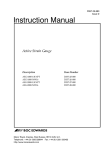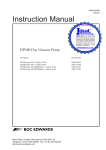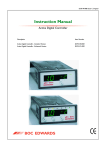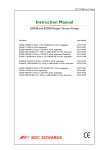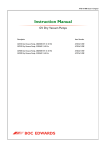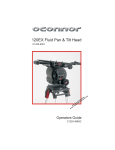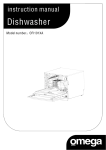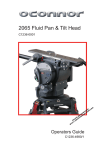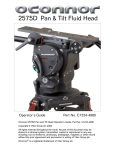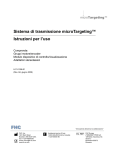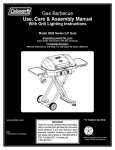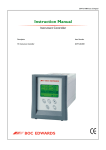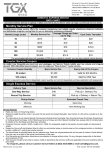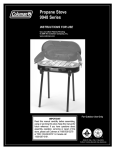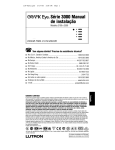Download AIGX ion gauge user manual
Transcript
D048-50-880 Issue C Instruction Manual Active Ion Gauge Description Item Number AIGX - S - NW25 AIGX - S - DN16CF AIGX - S - DN40CF D048-50-000 D048-51-000 D048-52-000 Manor Royal, Crawley, West Sussex, RH10 2LW, UK Telephone: +44 (0) 1293 528844 Fax: +44 (0) 1293 533453 http://www.bocedwards.com CONTENTS Section Title Page 1 1.1 1.2 INTRODUCTION Scope and definitions Description 1 1 1 2 2.1 2.2 2.3 2.3.1 2.3.2 2.3.3 2.3.4 2.3.5 2.3.6 2.4 TECHNICAL DATA Mechanical data Performance, operating and storage conditions Electrical data Electrical supply Output signal Gauge and degas enable Set-point Gauge identification Electrodes Materials exposed to vacuum 4 4 4 4 4 4 5 5 5 5 5 3 3.1 3.2 3.3 3.3.1 3.3.2 7 7 7 7 8 3.3.3 INSTALLATION Unpack and inspect Fit the AIGX to the vacuum system Electrical connections Connect to BOC Edwards AGC Connect to your own supply and control equipment Maximum cable length 8 10 4 4.1 4.2 4.2.1 4.3 4.4 4.5 4.6 4.7 4.8 4.9 4.10 OPERATION Enable and disable the AIGX Pressure measurement Calibration in different gases Emission current Degas the AIGX Over-pressure protection Filament selection LED status Set-point adjustment Error indication Bakeout 11 11 12 12 14 14 14 15 15 15 16 16 Active Ion Gauge i Section Title Page 5 5.1 5.2 5.3 5.4 MAINTENANCE Fault finding guide Replace the body tube Replace the internal fuse Calibration service 18 18 19 19 20 6 6.1 6.2 STORAGE AND DISPOSAL Storage Disposal 21 21 21 7 7.1 7.2 7.3 SPARES AND ACCESSORIES Introduction Spares Accessories 22 22 22 23 RETURN OF BOC EDWARDS EQUIPMENT Illustrations Figure 1 2 3 4 5 6 Title Page General view of the AIGX (NW25 version) 3 Dimensions (mm) 6 Schematic diagram of recommended electrical connections 9 Pressure output signal of AIGX 13 Separate the electronics housing from the body tube 17 Fuse replacement 20 Tables Table 1 2 3 4 5 6 ii Title Page Pins on the AIGX connector Maximum recommended cable length Gas calibration factors for various gases LED status Error indication Fault finding guide 8 10 12 15 16 18 Active Ion Gauge 1 INTRODUCTION 1.1 Scope and definitions This manual provides installation, operation and maintenance instructions for the BOC Edwards Active Ion Gauge (AIGX). You must use the AIGX as specified in the manual. Read this manual before you install and operate the AIGX. Important safety information is highlighted as WARNING and CAUTION instructions; you must obey these instructions. The use of WARNINGS and CAUTIONS is defined below. WARNING Warnings are given where failure to observe the instruction could result in injury or death to people. CAUTION Cautions are given where failure to observe the instruction could result in damage to the equipment, associated equipment or process. The units used throughout this manual conform to the SI international system of units of measurement. The following symbols appear on the AIGX: Warning (refer to accompanying documents) From August 2005, BOC Edwards will offer European customers a recycling service. 1.2 Description The AIGX is an ion gauge head and gauge controller in a single compact unit. The gauge operates as a hot filament ionisation gauge, in which the pressure is measured indirectly as a function of the current. Active Ion Gauge 1 The measurement range of the AIGX is 5 x 10 -10 to 5 x 10-2 torr (6.6 x 10-10 to 6.6 x 10-2 mbar). Three types of vacuum connections are available: DN16CF, DN40CF and NW25. The AIGX requires a 14.5 - 30 V d.c. power supply; it has a 0 to 10 V d.c. analogue output which is related to pressure. The AIGX is compatible with the BOC Edwards Active Gauge Controller (AGC). Alternatively, you can use an independent power supply and you can read the output signal with a voltmeter or analogue to digital converter. An 8-way electrical connector socket on the AIGX (Figure 1, item 1) is used to connect the AIGX to your AGC or electrical supply and voltmeter. Electrical cables fitted with suitable connectors are available as accessories. A gauge identification signal is available on the electrical connector: this signal is used by BOC Edwards AGC’s to identify which type of active gauge is connected. The AIGX is supplied with two filaments. A switch on top of the gauge selects between filament 1 and 2 (Figure 1, item 2). There are two levels of emission currents: 0.1 and 1 mA. The gauge will automatically select 1 mA emission current at low pressure, and 0.1 mA at high pressure. A protection circuit is built into the gauge to prevent operating the gauge -2 at pressures higher than 5 x 10 torr. The AIGX can be degassed using the degas feature. During degas, the grid voltage is 500 V and the emission current is 10 mA. The degas is inhibited at high pressure. The maximum duration of degas is three minutes, after which the gauge returns automatically to its normal mode. The AIGX has a set-point facility. The set-point signal is an open collector transistor output, which is on when the pressure measured by the gauge is below a preset pressure. The pressure at which the set-point operates can be adjusted using the set-trip switch on the top of the gauge (Figure 1, item 3). The AIGX is fitted with a status LED (Figure 1, item 4) . This LED indicates the operating status of the gauge. 2 Active Ion Gauge 4 1 3 2 5 1. 2. 3. Electrical connector Filament select switch Set trip switch 4. 5. Status LED Vacuum flange Figure 1 - General view of the AIGX (NW25 version) Active Ion Gauge 3 2 TECHNICAL DATA 2.1 Mechanical data Dimensions Mass AIGX-S-NW25 AIGX-S-DN16CF AIGX-S-DN40CF Volume of gauge tube Enclosure rating 2.2 Bakeout temperature Maximum operating altitude Maximum internal pressure Pressure measurement range 2.3 Electrical data 2.3.1 Electrical supply Voltage Internal fuse Maximum power consumption Operating Degas Electrical connector 0 to 40 °C -30 to 70 °C 90% RH (non-condensing) up to 31 °C reducing to 50 % RH at 40 °C 200 °C (with electronics removed) 2000 m 10 bar absolute 5 x 10 -10 to 5 x 10-2 torr (6.6 x 10-10 to 6.6 x 10-2 mbar) +14.5 V to +30 V d.c. 1 A (T) 7W 14 W FCC 68 (RJ45) Output signal Measurement range Gauge disabled Emission error Over-pressure trip Minimum load impedance 4 260 g 300 g 510 g 21 cm3 IP30 Performance, operating and storage conditions Ambient temperature operation storage Ambient humidity 2.3.2 See Figure 1 0.7 V to 8.7 V 9.0 V 9.5 V 9.7 V 10 kΩ Active Ion Gauge 2.3.3 Gauge and degas enable Control sense Active level 2.3.4 Active low < 1.5 V Set-point Trip level 0.6 V to 8.8 V Hysteresis 500 mV Set-point output load rating 30 V d.c., 100 mA max Back EMF suppression diode * Min surge rating 1A Min reverse voltage rating 100 V * required when you use an external d.c. relay connected to the set-point output 2.3.5 Gauge identification Identification resistance 2.3.6 162 kΩ Electrodes Emission current Normal Degas Grid voltage Normal Degas Filament bias voltage Collector voltage 2.4 0.1 or 1 mA 10 mA 180 V 500 V + 30 V 0V Materials exposed to vacuum Collector Grid Filament Body Feedthrough Active Ion Gauge Tungsten Tantalum Pt Clad Mo Yttria coated iridium Stainless Steel Stainless Steel and UHV compatible, glass/ceramic 5 A A NW25 85 DN16CF 106 DN40CF 98 Figure 2 - Dimensions (mm) 6 Active Ion Gauge 3 INSTALLATION 3.1 Unpack and inspect Remove all packing materials and protective covers and check the AIGX . If the AIGX is damaged, notify your supplier and the carrier in writing within three days; state the Item Number of the gauge together with your order number and your supplier’s invoice number. Retain all packing materials for inspection. Do not use the AIGX if it is damaged. If the AIGX is not to be used immediately, replace the protective covers. Store the AIGX in suitable conditions as described in Section 6. 3.2 Fit the AIGX to the vacuum system The AIGX can be mounted in any orientation. To avoid the build-up of debris or condensable material in the body tube of the AIGX (which will probably cause pressure measurement errors), we recommend that you install the AIGX vertically with the flange facing down. Use a copper gasket and screws to connect the DN16CF and DN40CF flanges of the AIGX to a similar flange on your vacuum system. Use an ‘O’ ring / centring-ring or Co-Seal and metal clamp to connect the NW25 flange of the AIGX to a similar flange on your vacuum system. Note: 3.3 ’O’ rings are not recommended for systems where UHV pressures are required. Electrical connections WARNING The AIGX must be connected to an earthed (grounded) vacuum system. For gauges with a NW25 flange, a conductive metallic clamping ring must be used. WARNING If the AIGX malfunctions, the AIGX pressure output may be incorrect. If such a failure could result in damage to equipment or cause injury to people, you must install a suitable control system to indicate the failure and, if necessary, to close down your process system. Active Ion Gauge 7 3.3.1 Connect to BOC Edwards AGC Connect the AIGX to the AGC using a cable which is terminated in suitable connectors. Suitable cables are available from BOC Edwards. Refer to Section 7.3. 3.3.2 Note: Your AGC must have a version of software that is compatible with the AIGX. If the AGC display shows ??? when the AIGX is plugged in, then an upgrade to the AGC software is required. Please contact BOC Edwards. Note: For cable lengths exceeding 10 m, cables with a larger conductor cross-section are required. Connect to your own supply and control equipment Note: Do not connect the electrical supply common (pin 2) to the signal common (pin 5). If you do, the AIGX pressure output signal will be inaccurate. A schematic diagram of the recommended electrical connections to the AIGX is shown in Figure 3. The pins on the AIGX connector are used as shown in Table 1. The specification of the electrical supply, d.c. relay and back EMF suppression diode are given in Section 2. Pin No. 1 2 3 4 5 6 7 8 Use Supply positive Supply common Signal output ID resistor Signal common Degas enable Gauge enable Set-point output Table 1 - Pins on the AIGX connector The connection to Pin 8 is optional. Make the connection to Pin 8 if you want to connect the set-point output signal to a d.c. relay. You must connect a suppression diode between pins 8 and 1 to protect the AIGX from transient voltage generated when the d.c. relay is switched off. Connect a switch between pins 7 and 2 to enable and disable the gauge. Connect a switch between pin 6 and 2 to enable and disable the degas function. 8 Active Ion Gauge KEY A B C D E F G AIGX connector (socket) Cable electrical (plug) Degas enable switch Gauge enable switch Back EMF suppression diode (optional) D.C. relay (optional) View of AIGX connector Figure 3 - Schematic diagram of recommended electrical connections Active Ion Gauge 9 3.3.3 Maximum cable length The maximum cable length is dependent on the conductor cross-section and the supply voltage used. The following maximum cable lengths are recommended: Conductor cross-section 24 awg 28 awg 24 V Supply 15 V Supply 30 m 10 m 0.5 m 1m Table 2 - Maximum recommended cable length The common mode signal voltage (that is, the voltage between signal common and supply common) could be as much as 2.5 V with long cables due to the voltage drop in the supply cable. You should ensure that the signal voltage measurement will operate correctly. 10 Active Ion Gauge 4 OPERATION WARNING Do not use the AIGX to measure the pressure of explosive or flammable gases or mixtures. WARNING During operation, the surface of the ion gauge tube might become hot. To avoid risk of injury, do not touch the tube whilst the gauge is operating. Switch off the gauge and allow to cool down for few minutes before handling. WARNING Disconnect the electrical supply cable from the AIGX before you remove the AIGX from the vacuum system. High voltages are generated inside the AIGX. 4.1 Enable and disable the AIGX CAUTION The gauge should not be operated at pressures higher than 5 x 10 -2 torr (6.6 x 10-2 mbar). Operating the AIGX at high pressures may reduce the lifetime of the filament. If you are using the AIGX with an AGC, refer to the AGC instruction manual for details of how to enable the AIGX. Alternatively, to enable (switch on) the AIGX, connect pin 7 to pin 2. To disable (switch off) the AIGX, disconnect pin 7 from pin 2. When the AIGX is enabled, the output signal will remain at 9.0 V whilst the emission current is being stabilised. This will take typically 5 seconds (may be longer at lower pressures). After this time the output signal will indicate pressure. If an error occurs, then the output signal will indicate the error. Active Ion Gauge 11 4.2 Pressure measurement If you are using an AIGX with an AGC, the pressure measurement is shown on the AGC display. Otherwise, convert the output signal to pressure using the following equation: P = 10 (V - 10) torr P = 10 (V - 9.875) mbar P = 10 (V - 7.875) Pa where V is the measured voltage in volts. Refer to Figure 4. This formula is valid for the range 0.7 V to 8.7 V. 4.2.1 Calibration in different gases The equation given in Section 4.2 is for air or nitrogen only. For other gases, the indicated pressure has to be multiplied by a gas calibration factor (GCF). The following table list the gas calibration factor for most commonly used gases. Gas GCF Helium Argon Neon Krypton Xenon Hydrogen Oxygen Carbon Monoxide Carbon Dioxide 5.7 0.75 3.3 0.5 0.35 2.4 1 1.15 0.7 Table 3 - Gas calibration factors for various gases 12 Active Ion Gauge 8 7 6 5 4 3 2 1 0 1E-10 1E-9 1E-8 1E-7 1E-6 1E-5 1E-4 1E-3 1E-2 1E-1 1E+0 1E+1 Indicated Pressure mbar torr Pascal Figure 4 - Pressure output signal of AIGX Active Ion Gauge 13 4.3 Emission current To increase the life time of the filament, the two levels of emission currents are automatically controlled by the gauge. As the pressure goes -5 down, the emission current changes from 0.1 mA to 1mA at 2 x 10 torr (2.6 x 10-5 mbar). As the pressure goes up, the emission current changes from 1 mA to 0.1 mA at 5 x 10-5 torr (6.6 x 10-5 mbar). 4.4 Degas the AIGX CAUTION You must degas the AIGX regularly. Failure to do so will affect the performance and reduce the lifetime of the gauge. During use in contaminating environments the gauge electrodes become coated in insulating layers, eventually resulting in premature failure of the product. This can be prevented by regular use of the degas feature. Typically, degas will be required on a weekly basis although the interval will depend on the level of contamination. The degas operation is also recommended if measurement of low pressure are required. During degas, the grid will be heated to high temperature, sufficient to remove absorbed gases and some contamination. Degas the AIGX when the pressure is below 1 x 10-5 torr (1.3 x 10-5 mbar). The degas is inhibited when the pressure is above 1 x 10-4 torr (1.3 x 10-4 mbar). The gauge will automatically return to the normal operation mode after 3 minutes. If you are using the AIGX with an AGC or a TIC controller, refer to the AGC or TIC instruction manual for details of how to degas the AIGX. Otherwise, to enable degassing of the AIGX, connect pin 6 to pin 2. 4.5 Over-pressure protection The gauge will automatically switch off when the measured pressure rises above 5 x 10-2 torr (6.6 x 10-2 mbar). If this occurs then the signal output and LED status will indicate over-pressure trip. Refer to Section 4.9. 14 Active Ion Gauge 4.6 Filament selection The AIGX has two filaments, 1 and 2. To select either of these filaments, use the sliding switch at the top of the gauge. Make sure that the gauge is turned off before switching between filaments. 4.7 LED status The AIGX is fitted with a tri-coloured LED which can be used to monitor the status of the gauge according to the following table: Colour Status Off Amber Green/Amber (alternating) Green Green (slow flashing) Red (flashing) Red No power to the gauge or malfunction Power on, gauge disabled Emissions start-up Emission on Degas on Emission error Over-pressure trip Table 4 - LED status 4.8 Set-point adjustment To read the voltage at which the set-point output signals are activated, press the required set trip switch (refer to Figure 1) with an appropriate tool. The output of the gauge will indicate the set trip level for 3 seconds after which the output will read the normal voltage output. To adjust the voltage at which the set-point output signal is activated, press the required set trip switch and hold it down for more than 3 seconds. The set-point voltage will start scrolling upwards. Remove pressure from the switch as soon as you reach the required trip voltage. To make a finer adjustment, remove pressure from the set trip switch and immediately depress the switch as many times as required. Each depression will increase the set trip voltage by approximately 10 mV. Refer to Section 4.2 to determine the operating voltage which corresponds to a given pressure. If required, the set-point signal can be used to indicate when the gauge is operating correctly. Adjust the set-point trip level to > 8.8 V. The set-point output will then be ON when the AIGX is operating normally. The set-point output will be OFF if the gauge is disabled or if an error condition is detected. Active Ion Gauge 15 4.9 Error indication If an error occurs during operation of the AIGX, then the output signal and the LED will indicate the error. Refer to Section 5.1 for a fault finding guide. Error Condition Output Signal Emission error Over-pressure trip 9.5 V 9.7 V LED Red flashing Red AGC Display EM ERR OVER R Table 5 - Error indication If an error is indicated then the AIGX will automatically turn off. You should disable the AIGX to remove the error indication, and correct the error. You may then re-enable the AIGX if required. Note: 4.10 If you are using the AIGX with an AGC, then the AGC will display an error message and disable the AIGX when an error occurs. In this case the LED status will return to OFF, and you should view the AGC display to determine the error. Bakeout The AIGX tube can be baked to temperatures up to 200 °C after removing the electronics housing. Refer to Figure 5 and the procedure in Section 5.2 to remove and refit the electronics housing. Ensure that the tube has cooled down before refitting the electronics housing. 16 Active Ion Gauge 1 2 4 2 3 1. 2. Electronics housing Fixing screws 3. 4. Body tube assembly Locating lugs Figure 5 - Separate the electronics housing from the body tube Active Ion Gauge 17 5 MAINTENANCE WARNING Disconnect the electrical supply cable before you start any maintenance. High voltages are generated inside the AIGX. 5.1 Fault finding guide Symptom LED Not Lit Possible Cause Remedy Supply connection incorrect Check electrical supply and connections. or faulty. Supply polarity reversed. Internal fuse blown. Replace fuse. Refer to Section 5.3 Over-pressure trip The pressure rose too high whilst the AIGX was operating. Reduce the pressure and re-enable the AIGX. Emission error The AIGX was enabled when the pressure was too high. Reduce the pressure and re-enable the AIGX. Filament contaminated. Filament open circuit. Switch to the other filament. If both filaments give the error, replace the body tube. Refer to Section 5.2. Electrical supply insufficient Check that supply to drive the AIGX. voltage/current specifications meet requirement in Section 2.3.1. Table 6 - Fault finding guide 18 Active Ion Gauge 5.2 Replace the body tube Refer to Figure 5 and use the following procedure to replace the body tube. 1. Turn off the gauge. 2. Switch off the AIGX electrical supply and disconnect the electrical supply cable. 3. Remove the AIGX from the vacuum system. 4. Using a suitable screwdriver, remove the two M3 screws (item 2) from the sides of the electronics housing (item 1). 5. Pull the electronics housing (item 1) to remove it from the body tube assembly (item 3). 6. Fit the new body tube assembly (item 3) to the electronics housing (item 1). Take care to ensure that the locating lugs (item 4) on the body tube assembly (item 3) are aligned with the mating recess in the electronics housing (item 1). Note that the electronics housing (item 1) can only fit one way round on the body tube assembly (item 3). 7. Refit the two M3 screws to the sides of the AIGX. 5.3 Replace the internal fuse If you suspect that the internal fuse has blown, you should check that the voltage and polarity of the electrical supply are correct before replacing the fuse. To replace the fuse refer to Figure 6 and use the following procedure: 1. Switch off the electrical supply and remove the electrical supply connector from the gauge. 2. Using a suitable screwdriver, remove the four M3.5 screws from the top of the gauge. 3. Remove the gauge lid, ensuring the pin on the underside of the lid is not bent. 4. The fuse will now be visible on the PCB. Hold the board down and then pull the fuse from it’s fuseholder using an appropriate tool (for example, a small pair of pliers). Active Ion Gauge 19 5. The replacement fuse is supplied mounted in a fuseholder. Remove the new fuse from its fuseholder and discard the new fuseholder. 6. Push the new fuse into the fuseholder on the PCB. 7. Refit the gauge lid ensuring that the pin is fitted in the shrouded earth socket next to the main connector. Refit the four M3.5 screws. 8. Apply power to the gauge and check that the LED is illuminated. Replacement fuses are available from BOC Edwards. Refer to Section 7.2. 2 1 1. Fuse holder 2. Shrouded earth socket Figure 6 - Fuse replacement 5.4 Calibration service A calibration service is available for all BOC Edwards gauges. Calibration is by comparison with reference gauges, traceable to National Standards. Contact BOC Edwards for details. 20 Active Ion Gauge 6 STORAGE AND DISPOSAL 6.1 Storage Return the AIGX to its protective packaging and store the AIGX in clean dry conditions until required for use. Do not exceed the storage temperature conditions specified in Section 2. When required for use, prepare and install the AIGX as described in Section 3. 6.2 Disposal Disposal of the AIGX in accordance with all local and national safety and environmental requirements. Alternatively, you may be able to recycle the AIGX and/or cables; contact BOC Edwards or your supplier for advice (also see below). The AIGX and associated cables are within the scope of the European Directive on Waste Electrical and Electronic Equipment, 2002/96/EC. From August 2005, BOC Edwards will offer European customers a recycling service for the AIGX/cables at the end of the product’s life. Contact BOC Edwards for advice on how to return the AIGX/cables for recycling. Active Ion Gauge 21 7 SPARES AND ACCESSORIES 7.1 Introduction BOC Edwards products, spares and accessories are available from BOC Edwards companies in Belgium, Brazil, Canada, France, Germany, Great Britain, Hong Kong, Italy, Japan, Korea, Switzerland, U.S.A, and a world wide network of distributors. The majority of these centres employ Service Engineers who have undergone comprehensive BOC Edwards training courses. Order spare parts and accessories from your nearest BOC Edwards company or distributor. When ordering, please state for each part required: 7.2 • Model and Item Number of your equipment • Serial number (if any) • Item Number and description of part Spares Description Electronics housings AIGX-S Body tubes NW25 DN16CF DN40CF Spare fuses (pack of 5) 22 Item Number D048-50-800 D048-50-801 D048-51-801 D048-52-801 D048-50-805 Active Ion Gauge 7.3 Accessories Cables suitable for use with the AIGX are as follows. These cables are supplied with 8-way male electrical connectors on both ends. Note that the 15 m and 30 m cables have a larger conductor cross-section. Cable length Item Number 0.5 m 1m 3m 5m 10 m 15 m 30 m D400-01-005 D400-01-010 D400-01-030 D400-01-050 D400-01-100 D400-05-150 D400-05-300 Description Item Number Annealed copper gasket - DN16CF Hex head nut, bolt and washer kit - DN16CF Annealed copper gasket - DN40CF Hex head nut, bolt and washer kit - DN40CF C100-01-270 C100-01-630 Active Ion Gauge C100-05-270 C100-05-630 23 24 Active Ion Gauge Form HS1 Return of BOC Edwards Equipment - Procedure INTRODUCTION Before returning your equipment, you must warn BOC Edwards if substances you used (and produced) in the equipment can be hazardous. This information is fundamental to the safety of our Service Centre employees and will determine the procedures employed to service your equipment. Complete the Declaration (HS2) and send it to BOC Edwards before you dispatch the equipment. It is important to note that this declaration is for BOC Edwards internal use only, and has no relationship to local, national or international transportation safety or environmental requirements. As the person offering the equipment for shipment, it is your responsibility to ensure compliance with applicable laws. P900-70-000 Issue K GUIDELINES • Equipment is 'uncontaminated' if it has not been used, or if it has only been used with substances that are not hazardous. Your equipment is 'contaminated' if it has been used with any substances classified as hazardous under EU Directive 67/548/EEC (as amended) or OSHA Occupational Safety (29 CFR 1910). • If your equipment has been used with radioactive substances, biological or infectious agents, mercury, polychlorinated biphenyls (PCB’s), dioxins or sodium azide, you must decontaminate it before you return it to BOC Edwards. You must send independent proof of decontamination (for example a certificate of analysis) to BOC Edwards with the Declaration (HS2). Phone BOC Edwards for advice. • If your equipment is contaminated, you must either: • Remove all traces of contamination (to the satisfaction of laws governing the transportation of dangerous/hazardous substances). • Or, properly classify the hazard, mark, manifest and ship the equipment in accordance with applicable laws governing the shipment of hazardous materials. Note: Some contaminated equipment may not be suitable for airfreight. PROCEDURE 1. Contact BOC Edwards and obtain a Return Authorisation Number for your equipment. 2. Complete the Return of BOC Edwards Equipment - Declaration (HS2). 3. If the equipment is contaminated, you must contact your transporter to ensure that you properly classify the hazard, mark, manifest and ship the equipment, in accordance with applicable laws governing the shipment of contaminated/hazardous materials. As the person offering the equipment for shipment, it is your responsibility to ensure compliance with applicable law. Note: Equipment contaminated with some hazardous materials, such as semiconductor by-products, may not be suitable for airfreight - contact your transporter for advice. 4. Remove all traces of hazardous gases: pass an inert gas through the equipment and any accessories that will be returned to BOC Edwards. Where possible, drain all fluids and lubricants from the equipment and its accessories. 5. Seal up all of the equipment's inlets and outlets (including those where accessories were attached) with blanking flanges or, for uncontaminated product, with heavy gauge tape. 6. Seal equipment in a thick polythene/polyethylene bag or sheet. 7. If the equipment is large, strap the equipment and its accessories to a wooden pallet. If the equipment is too small to be strapped to a pallet, pack it in a suitable strong box. 8. Fax or post a copy of the Declaration (HS2) to BOC Edwards. The Declaration must arrive before the equipment. 9. Give a copy of the Declaration (HS2) to the transporter. You must tell your transporter if the equipment is contaminated. 10. Seal the original Declaration in a suitable envelope: attach the envelope securely to the outside of the equipment package, in a clear weatherproof bag. WRITE YOUR RETURN AUTHORISATION NUMBER CLEARLY ON THE OUTSIDE OF THE ENVELOPE OR ON THE OUTSIDE OF THE EQUIPMENT PACKAGE. Form HS2 Return of BOC Edwards Equipment - Declaration Return Authorisation Number: You must: • Know about all of the substances which have been used and produced in the equipment before you complete this Declaration • Read the Return of BOC Edwards Equipment - Procedure (HS1) before you complete this Declaration • Contact BOC Edwards to obtain a Return Authorisation Number and to obtain advice if you have any questions • Send this form to BOC Edwards before you return your equipment SECTION 1: EQUIPMENT Equipment/System Name_________________________ IF APPLICABLE: Part Number _________________________________ Tool Reference Number_________________ Serial Number_________________________________ Process ______________________________ Has the equipment been used, tested or operated ? Failure Date___________________________ YES Serial Number of Replacement Equipment_________________ R Go to Section 2 NO R Go to Section 4 SECTION 2: SUBSTANCES IN CONTACT WITH THE EQUIPMENT Are any substances used or produced in the equipment: • • Radioactive, biological or infectious agents, mercury, poly chlorinated biphenyls (PCBs), dioxins or sodium azide? (if YES, see Note 1) YES NO R YES R Hazardous to human health and safety? R NO R Note 1 : BOC Edwards will not accept delivery of any equipment that is contaminated with radioactive substances, biological/infectious agents, mercury, PCB’s, dioxins or sodium azide, unless you: • • Decontaminate the equipment Provide proof of decontamination YOU MUST CONTACT BOC EDWARDS FOR ADVICE BEFORE YOU RETURN SUCH EQUIPMENT SECTION 3: LIST OF SUBSTANCES IN CONTACT WITH THE EQUIPMENT Chemical Symbol Substance name Precautions required (for example, use protective gloves, etc.) Action required after a spill, leak or exposure SECTION 4: RETURN INFORMATION Reason for return and symptoms of malfunction _________________________________________________ _________________________________________________________________________________ If you have a warranty claim: • who did you buy the equipment from ? _____________________________ • give the supplier’s invoice number_________________________________ SECTION 5: DECLARATION Print your name:_________________________________Print your job title:_________________________ Print your organisation:____________________________________________________________________ Print your address:_______________________________________________________________________ Telephone number: ___________________________Date of equipment delivery: ______________ I have made reasonable enquiry and I have supplied accurate information in this Declaration. I have not withheld any information, and I have followed the Return of BOC Edwards Equipment - Procedure (HS1). Signed: _____________________________________Date______________ Note: Please print out this form, sign it and return the signed form as hard copy. P900-71-000 Issue K _______________________________________________________________________ This page intentionally blank. EUROPE/UNITED KINGDOM BOC EDWARDS Manor Royal Crawley West Sussex, RH10 9LW Tel +(44) 1293 528844 Fax +(44) 1293 533453 AMERICAS USA HEADQUARTERS BOC EDWARDS One Edwards Park 301 Ballardvale Street Wilmington, MA 01887 Tel +(1) 978 658 5410 Toll Free (USA only) 1800 848 9800 Fax +(1) 978 658 5410 3901 Burton Drive Santa Clara, CA 95054 Tel +(1) 408 496 1117 Fax +(1) 408 496 1118 1810 West Drake Drive Suite 101 Tempe, AZ 85283 Tel +(1) 480 777 7007 Fax +(1) 480 777 2244 4117 Commercial Center Drive Austin, TX 78744 Tel +(1) 512 416 0102 Fax +(1) 512 328 9846 3501 Island Avenue Philadelphia, PA 19153 Tel +(1) 215 365 8653 Fax +(1) 978 756 6846 U.S. National Sales Center Mon 8:30 A. M. - 8:00 P.M. EST Tues 8:30 A. M. - 8:00 P.M. EST Wed 8:30 A. M. - 8:00 P.M. EST Thurs 8:30 A. M. - 8:00 P.M. EST Fri 8:30 A. M. - 6:30 P.M. EST P800-80-000 Issue K 01A09-010 BELGIUM BOC EDWARDS Bergensesteenweg 709 B1600 Sint-Pieters-Leeuw Brussels Tel +(32) 2 363 0030 Fax +(32) 2 363 0064 BRAZIL BOC DO BRAZIL LTDA Rua Bernado Wrona 222 02710 São Paulo-SP Brazil Tel +(55) 11 3952 5000 Fax +(55) 11 3965 2766 CANADA BOC EDWARDS 5975 Falbourne Street Mississauga, Ontario L5R3W6 Canada Tel +(1) 800 387 4076 Fax +(1) 905 501 1225 12055 Cote de Liesse Dorval, Quebec H9P1B4 Canada Tel +(1) 514 631 3501 Fax +(1) 514 631 3502 CHINA BOC TRADING (SHANGHAI) CO. LTD 23 Fu Te Road(N), Wai Gao Qiao Free Trade Zone Pudong, Shanghai, 200131, PRC, China Tel +(86 21) 58669618 Fax +(86 21) 58669993 GERMANY BOC EDWARDS Ammerthalstraße 36 85551 Kirchheim Munich Tel +(49) 89 99 19 18 0 Fax +(49) 89 99 19 18 99 FRANCE BOC EDWARDS 125 Avenue Louis Roche 92238 Gennevillers, Cedex Paris Tel +(33) 1 47 98 24 01 Fax +(33)1 47 98 44 54 HONG KONG S.A.R. BOC EDWARDS (ASIA) 12 Chun Yat Street Tseung Kwan O Industrial Estate Tseung Kwan O, Kowloon Hong Kong SAR Tel +(852) 2372 2640 Fax +(852) 2796 9095 INDIA BOC EDWARDS DIVIN. OF BOC INDIA LIMITED 203 Surya Kiran Building 19 Kasturba Gandhi Marg New Delhi - 110 001 India Tel +(91) 11 237 33087 Fax +(91) 11 551 0245 ISRAEL EDWARDS ISRAEL VACUUM LTD 5 Habarzel Blvd Gat 2000 Industrial Zone Qiryat Gat 82000 Tel +(972) 8 681 0633 Fax +(972) 8 681 0640 ITALY BOC EDWARDS Via Carpaccio 35 20090 Trezzano sul Navigilo Milan Tel +(39) 2 48 4471 Fax +(39) 2 48 401638 JAPAN HEADQUARTERS BOC EDWARDS Shwa Shiba Park Building A-3F 2-4-1 Shibakoen Minato-ku Tokyo, 105-0011 Tel +(81)(0) 3 5470 6530 Fax +(81)(0) 3 5470 6521 KOREA HEADQUARTERS SONGWON EDWARDS LTD 5th FL. Daewoo Engineering Bldg. Soonae-dong Bundang-gu, Sungnam City Kyungki-do, Korea Tel +(82) 31 716 7070 Fax +(82) 31738 1001 SONGWON EDWARDS LTD 625-7 Upsong-dong Chunan City Chungchong Nam-do Korea Tel +(82) 41 621 7070 Fax +(82) 41 621 7700 SINGAPORE BOC EDWARDS (ASIA) 42 Loyang Drive Loyang Indusrial Estate Singapore 508962 Tel +(65) 546 8408 Fax +(65) 546 8407 TAIWAN, R.O.C. EDWARDS TAIWAN LIMITED No. 434 Chung-hua Road Toufen Town, Miaoli County Taiwan R.O.C. Tel +(886) 37 611422 Fax +(886) 37 611401 PLEASE CONTACT ANY OF THE ABOVE FOR DETAILS OF OTHER SALES AND SERVICE CENTERS IN YOUR AREA. BOC Edwards is part of BOC Limited. BOC Edwards and the stripe symbol are trade marks of The BOC Group © BOC Edwards 2004 Publication No. C100-04-895 www.bocedwards.com [email protected]
































